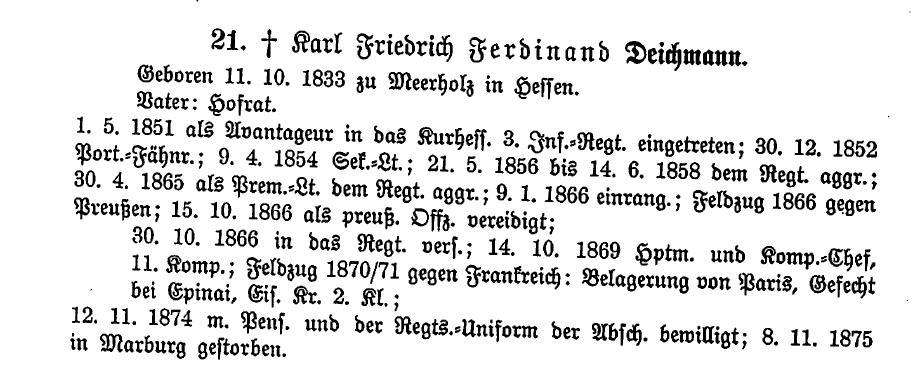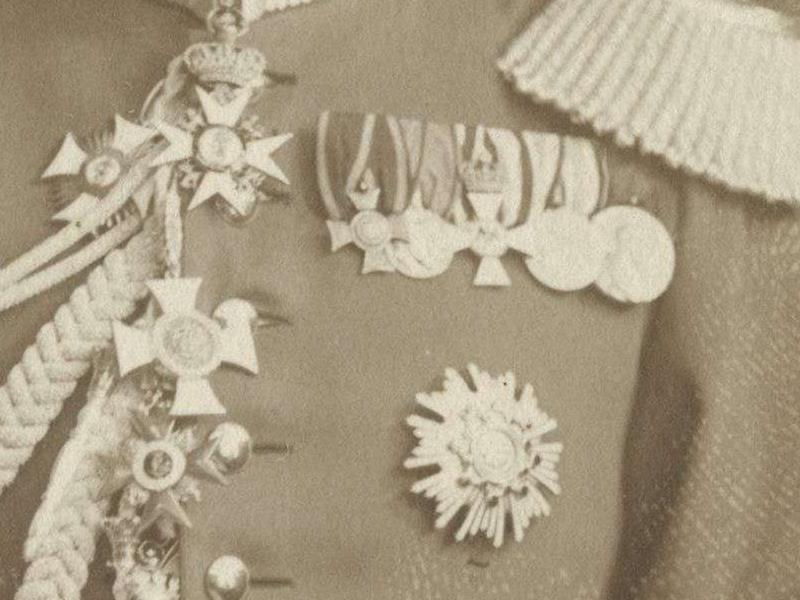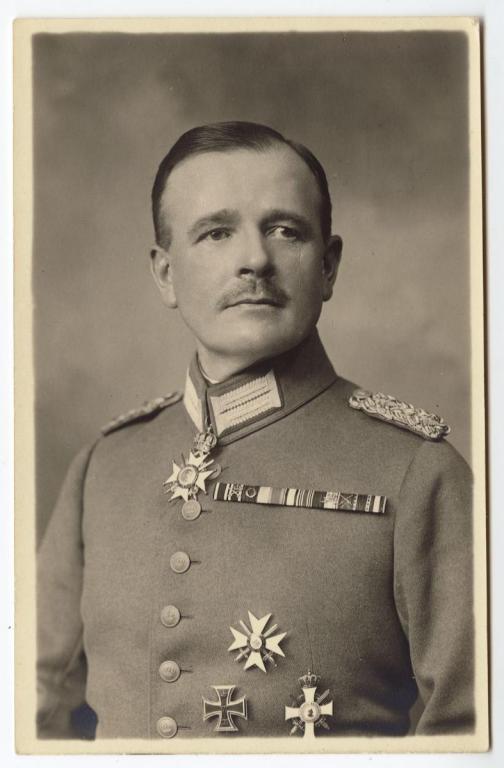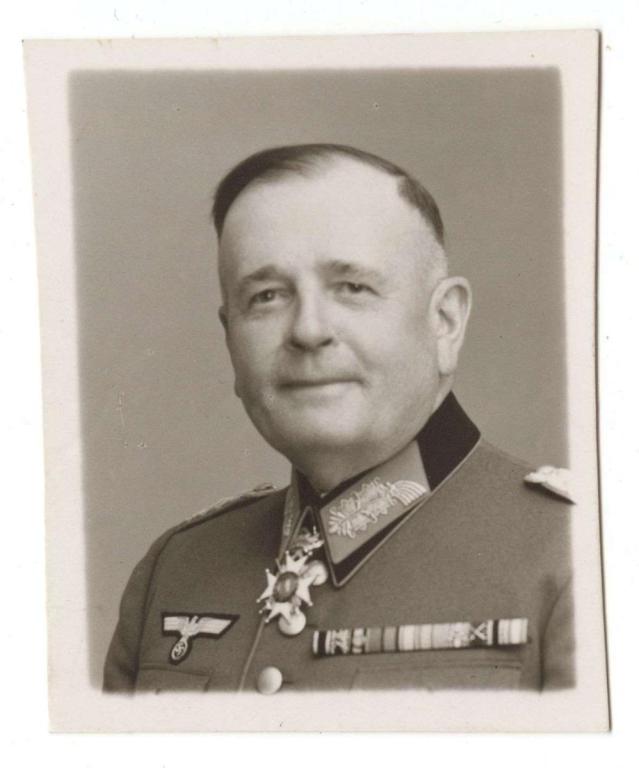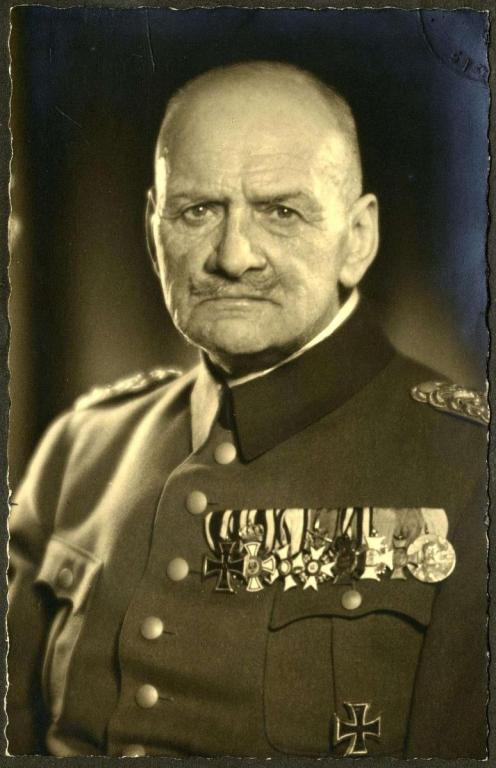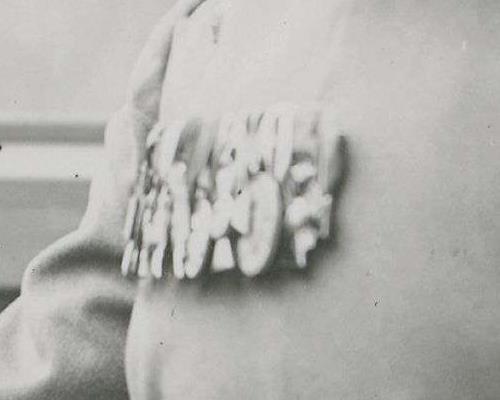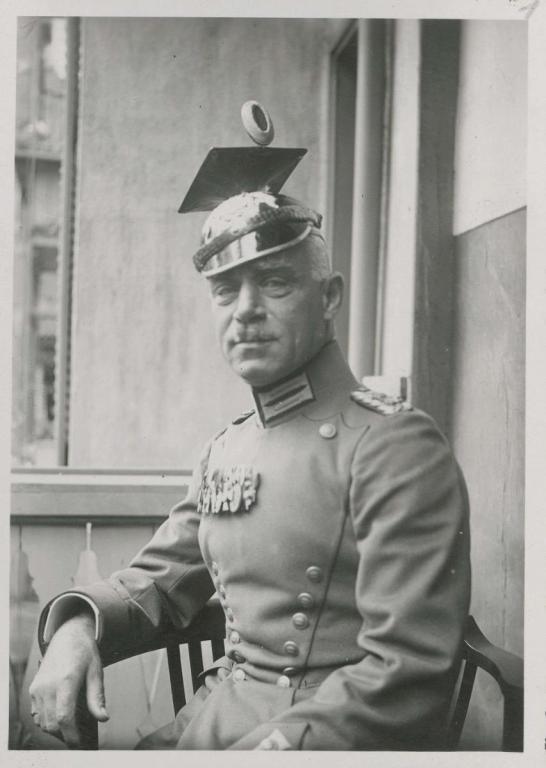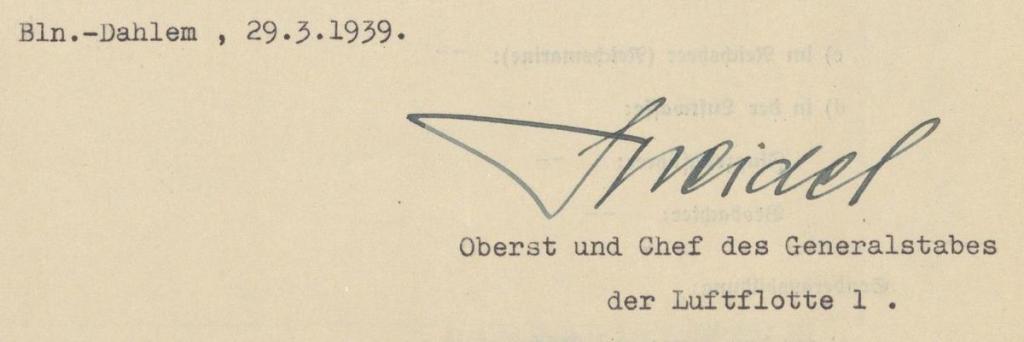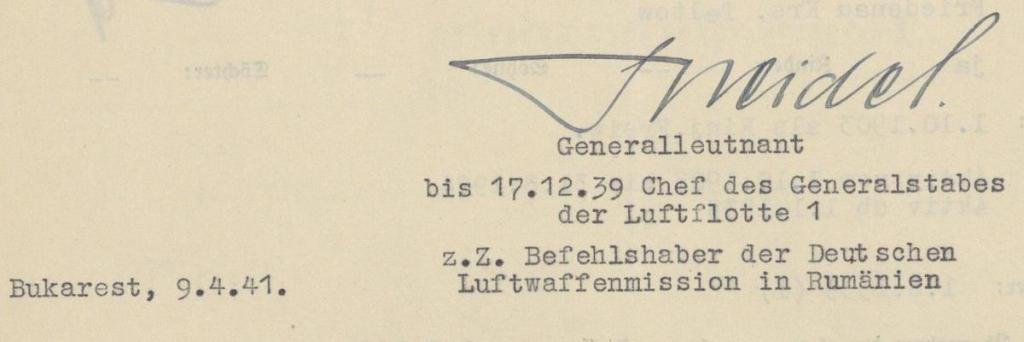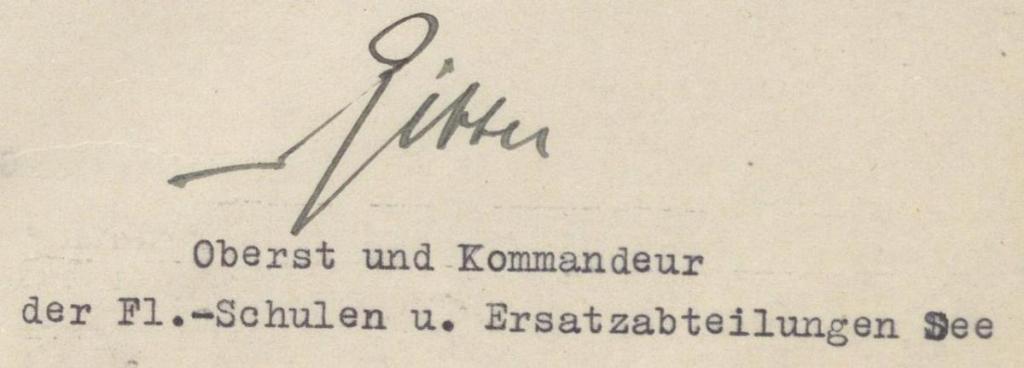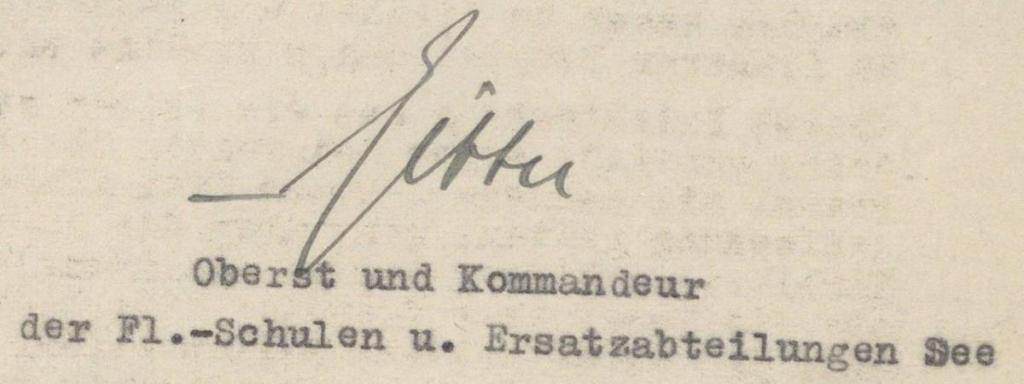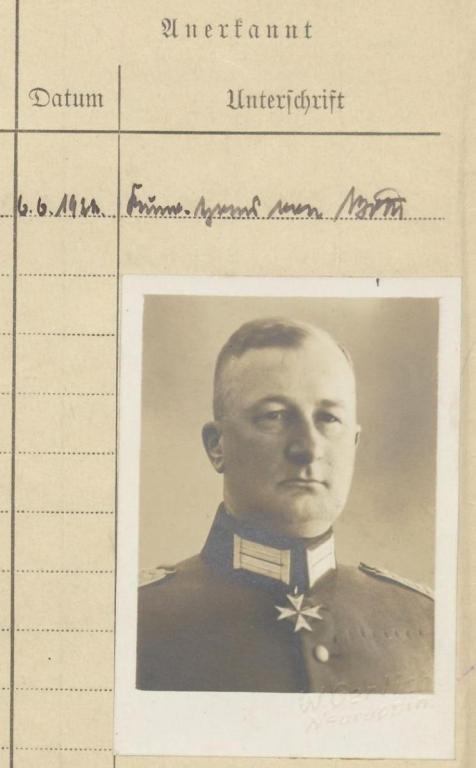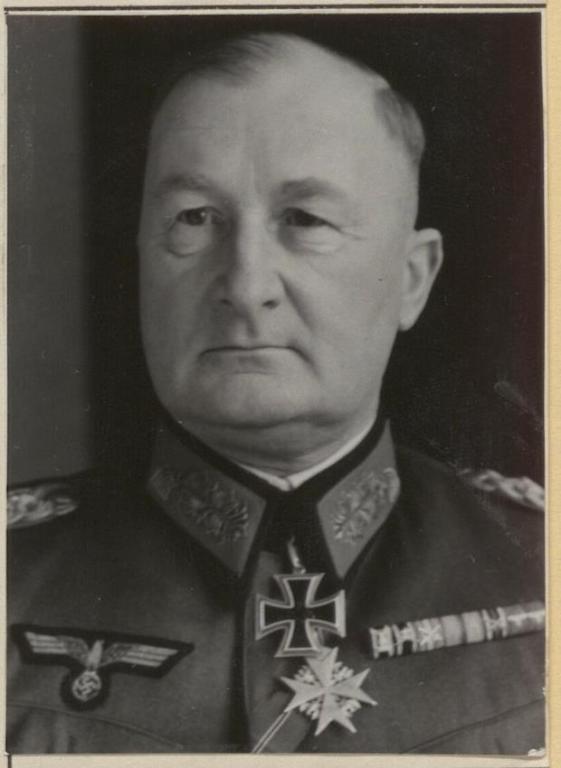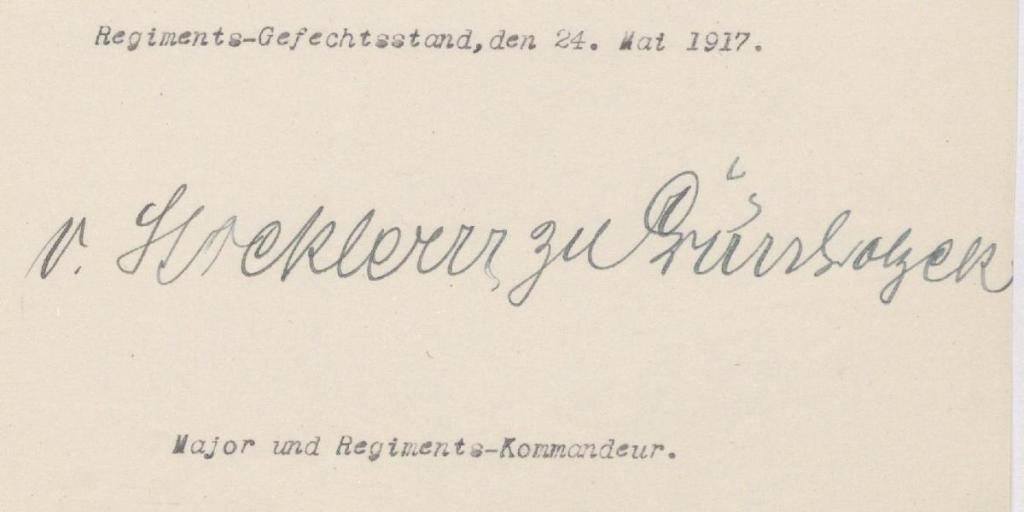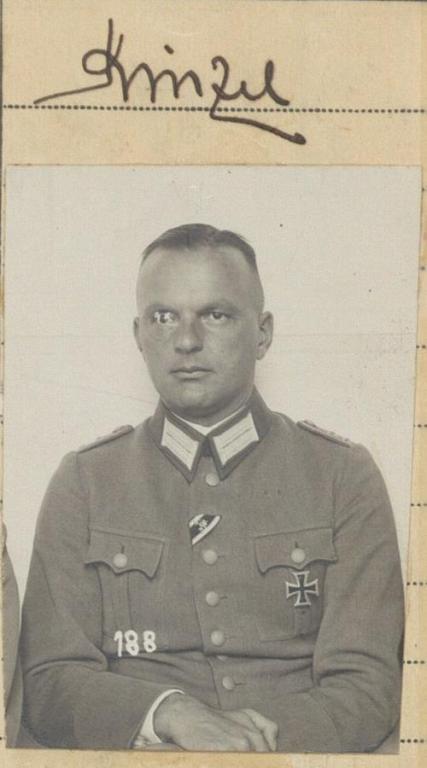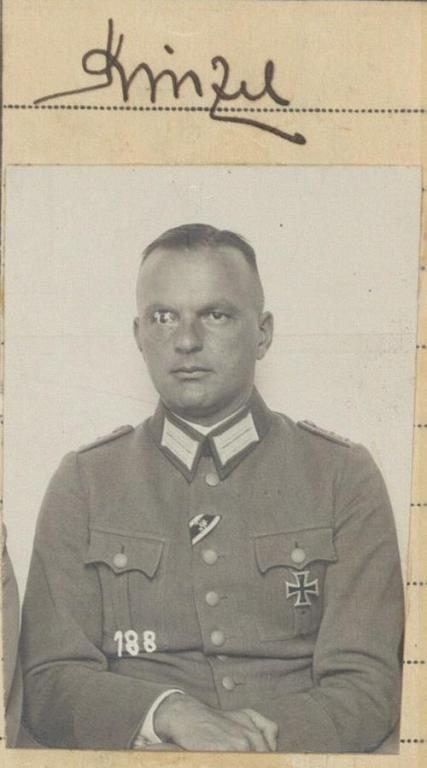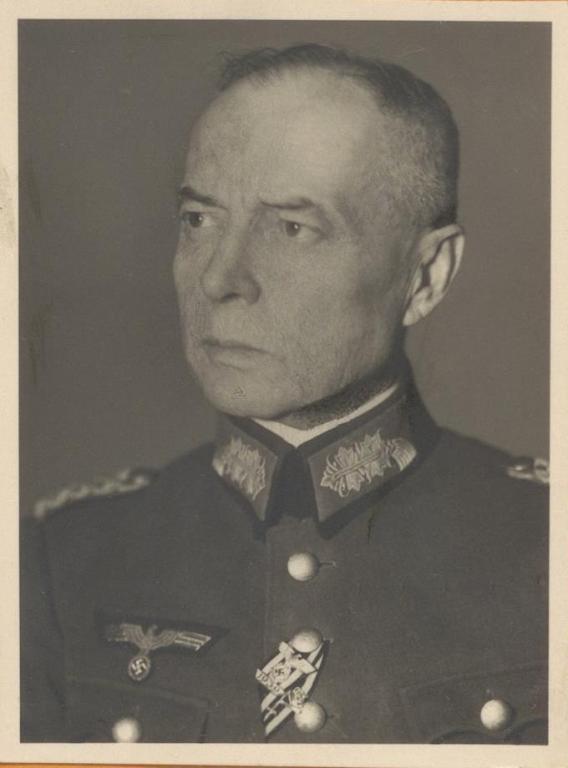-
Posts
4,908 -
Joined
-
Last visited
-
Days Won
97
Content Type
Profiles
Forums
Blogs
Gallery
Events
Store
Everything posted by Dave Danner
-
The Geschichte der waldeckischen und kurhessischen Stammtruppen des Infanterie-Regiments v. Wittich (3. Kurhess.) Nr. 83 1681-1866, published in 1909, has as Anlage 18: "Rangliste des 3. Inf. Rgts. (Prinz Friedrich Wilhelm) bei seiner Auflösung im Jahre 1966, nebst Nachweisen über die ferneren Schicksale seiner Offiziere" with information on 43 officers. It is on Ancestry.
-
Taking a quick look through the FR 86 Stammliste, I see also Carl Schaeffer (1840-1870) from the 1. kurhess. IR, Emil von Borck (1841-1900) from the 2. kurhess. IR, Gustav Schultheis (1833-1899) from the 3. kurhess. IR, Julius von Langenschwarz (1827-?) from the kurhess. Schützen-Bataillon, and Ferdinand Claus (1828-1890) and Johann Auffarth (1830-1902) from from the kurhess. Jäger-Bataillon.
-
From the FR 86 Stammliste: His son Paul Deichmann (*1873) was also an FR 86 officer. His grandson Paul, the later General der Flieger, was also in FR 86 like his uncle and grandfather. General der Flieger Paul Deichmann's parents were Gärtnereibesitzer Karl Deichmann (*1872) and Ottilie, geb. Fösser (1867-1906).
-
A question about Eugen v. Dorrer's decorations. According to his 1908/09 Deutscher Ordens-Almanach entry, Dorrer had the WJM2, which is the 1889 Silberne Erinerrungsmedaille zum 25-jährigen Regierungsjubiläum König Karls. However, in the photo below, which dates from after the DOA was published, Dorrer is not wearing the Regierungsjubiläummedaille. Instead, we see the Dienstehrenzeichen 1. Klasse, the 1911 Silberne Hochzeitsmedaille, the RAO3Kr, the China-Denkmünze in Stahl and the Centenarmedaille. Does anyone have any idea why he wouldn't be wearing the medal? Or if it's possible that the DOA entry is wrong? The full version of his portrait is here: http://www.landesarchiv-bw.de/plink/?f=1-364166-4
- 1 reply
-
1
-
From the photo collection in the Landesarchiv Baden-Württemberg (http://www.landesarchiv-bw.de/plink/?f=1-328970), two more versions of the two photos above. Of note is that it is the same ribbon bar in both photos, from 1918 and 1940. In the AHF thread here, Thierry posted a picture of three differing ribbon bars for Sauter, which I've also added below. There's something shown in the two photos that Rick L. would have appreciated. You can see the difference in photo processing, where in the 1918 photo the yellows of the WM3 and the Centenary turn dark, while in the 1940 photo they remain light. Note that in the 1940 photo Generalmajor z.V. Sauter is not wearing either of the post-1934 ribbon bars with the Ehrenkreuz für Frontkämpfer. Both of those ribbon bars have the wrong precedence, though. The first places the Württemberg Dienstehrenzeichen 1. Klasse, a decoration, after the China-Denkmünze in Stahl. The third places the Hamburg Hanseatenkreuz among the non-wartime decorations and medals instead of before the Ehrenkreuz für Frontkämpfer where it belongs. Both also omit the Bavarian Militär-Verdienstorden 3. Klasse mit der Krone und Schwertern seen on the 1918 ribbon bar, but that's because Sauter received the pinback Offizierskreuz of that order on 18.10.1918. The third also has swords on the Friedrichs-Orden ribbon, which is incorrect. I suppose the tailor messed up and Sauter rejected them for wear, but they remained in existence, either in his own possession or the tailor's, and resurfaced later.
-
Eugen Otto Clausen (14.7.1872-26.2.1943) was a retired Württemberg officer at the start of World War I, having left active duty as a Rittmeister on 18.10.1911. During World War I, he served at the Postüberwachungsstelle für Briefe in Stuttgart, and received the Charakter of Major a.D. on 2.8.1917. He was the son of Generalleutnant Otto von Clausen (1831-1911) and brother of Hauptmann der Landwehr/Reserve Gaston-Otto Clausen (1869-1920). He also had a twin brother, Carl Clausen (1872-1908), who died while a Rittmeister in DR 26. There's a cool photo of the twins from around 1905 with Eugen in the uniform of a 1732 Kreis-Jäger zu Pferde and Carl in the uniform of an 1805 Herzog-Louis-Jäger zu Pferde here: http://www.landesarchiv-bw.de/plink/?f=1-325990-1 Eugen's known decorations from the rank lists and Württemberg Militär-Verordnungsblatt were the Russian Order of St. Anne 3. Class (29.4.1908), the Prussian Roter-Adlerorden 4. Klasse (7.9.1909), the Württemberg Friedrichs-Orden Ritterkreuz 1. Klasse (18.10.1911) and the Württemberg Wilhelmskreuz mit Schwertern (5.10.1916). However, as can be seen by the photos below, he appears to have several more decorations. Unfortunately, the angle of the photo makes it unclear what they are. As best as I can tell, there are eight in total. I would guess that the Iron Cross 2nd Class is first. He appears to have the Centenary Medal after the RAO4, although I do not know why, as he was with 5./UR 19 at Kloster Wiblingen south of Ulm in the 1897 rank list. I would also guess that the medal before the RAO4 is the 1911 Württemberg silberne Hochzeitsmedaille, as Clausen was with the Schloßgarde-Kompagnie in Stuttgart prior to retiring. Any guesses what the other(s) might be? Maybe a Dienstehrenzeichen 1. Klasse? None was gazetted by 1918, but I don't know if there were later awards as with the Prussian Dienstauszeichnungskreuz through 1920.
-
1
-

imperial 1914-1918 Heuduck, Hans von
Dave Danner posted a topic in Germany: All Eras: Signature Database
Heuduck, Hans Wilhelm Konrad von * 18. Juni 1861 in Stendal † 4. Juni 1930 07.06.1908 Kommandeur des Husaren-Regiments Nr. 13 08.04.1913 Kommandeur der 14. Kavallerie-Brigade 03.09.1916 Kommandeur der 1. Kavallerie-Division xx.xx.1918 Kommandeur der 44. Landwehr-Division 23.05.1918 Kommandeur der 7. Kavallerie-Schützen-Division 09.02.1919 General-Inspekteur der Kavallerie 14.02.1919 Kommandeur der Garde-Kavallerie-Schützen-Division xx.05.1919 Kommandeur der Reichswehr-Brigade 30 Highest rank reached: Generalleutnant Example from 6 July 1918: -
Speidel, Wilhelm * 8. Juli 1895 in Metzingen † 3. Juni 1970 in Nürtingen Chef des Generalstabes des Luftkreis-Kommandos III Chef des Generalstabes des Luftwaffengruppen-Kommandos 1 Chef des Generalstabes der Luftflotte 1 Chef des Generalstabes der Luftflotte 2 Befehlshaber der deutschen Luftwaffenmission in Rumänien Kommandierenden General und Befehlshaber Südgriechenland Militärbefehlshaber Griechenland Kommandeur des Verbindungsstabes des Oberkommandos der Luftwaffe Südost Kommandierenden General des Feldjäger-Kommandos III bzw. Feldjäger-Korps III Highest rank reached: General der Flieger https://www.lexikon-der-wehrmacht.de/Personenregister/S/SpeidelWilhelm.htm https://de.wikipedia.org/wiki/Wilhelm_Speidel_(General)
-
Ritter, Hans * 2. März 1893 in Harburg an der Elbe † 21. Mai 1991 in München 1936 Höherer Kommandeur der Fliegerschulen und der Fliegerersatzabteilungen See 1939 General der Luftwaffe beim Oberbefehlshaber der Kriegsmarine und Befehlshaber der Marinefliegerverbände 1939-1940 zugleich Inspekteur der Seeflieger im Reichsluftfahrtministerium 1944 Führerreserve OKL 1945 entlassen Highest rank reached: General der Flieger https://de.wikipedia.org/wiki/Hans_Ritter_(General) https://www.lexikon-der-wehrmacht.de/Personenregister/R/RitterHans.htm Two examples from 1938:
-

Luftwaffe Stumpff, Hans-Jürgen
Dave Danner replied to hucks216's topic in Germany: All Eras: Signature Database
-

Heer Both, Kuno-Hans von
Dave Danner replied to hucks216's topic in Germany: All Eras: Signature Database
-

imperial 1914-1918 Bergmann, Walter von
Dave Danner replied to Dave Danner's topic in Germany: All Eras: Signature Database
-

heer Euler, Friedrich
Dave Danner replied to hucks216's topic in Germany: All Eras: Signature Database
*27.10.1883 in Hannover He was an Oberleutnant, then Hauptmann, in Feldartillerie-Regiment Nr. 35 in World War I. He remained in the Reichsheer and was a Rittmeister in the 2. Reiter-Regiment. He left the Reichsheer in 1925/26 as a Major a.D. I am not sure what he did in the Zwischenzeit, as his Personalakte was not in the National Archives, but he may have been a Landesschutz-Offizier, as he had enough seniority to be reactivated as an Oberstleutnant (E) with an RDA of 1.2.1931 and was promoted to Oberst (E) on 1.3.1937. Since he turned 60 in 1943, he was likely retired on age grounds. -

heer Schleinitz, Hans-Wolfgang Freiherr von
Dave Danner replied to hucks216's topic in Germany: All Eras: Signature Database
Hans-Wolfgang Siegbold Richard *10.7.1885 in Berlin †27.10.1963 in Königssee, Oberbayern Kommandeur des Wehrbezirkskommandos Trier I. -
Kinzel, Eberhard *18.10.1897 in Friedenau bei Berlin †25.6.1945 near Idstedt (Suicide) https://en.wikipedia.org/wiki/Eberhard_Kinzel https://de.wikipedia.org/wiki/Eberhard_Kinzel Highest rank reached: General der Infanterie The file photo and signature below dates from the early to mid-1930s, before the introduction of the Hoheitszeichen. A 1943 example is below that.
- 1 reply
-
1
-
The Major d.L. Hennig who received the HOH3X on 21.5.1918 with Reserve-Feldartillerie-Regiment Nr. 13 was named Georg. In the 1914 rank list, he is listed as a Hptm.d.L.-Felda. II (VI Berlin). The 1911 rank list of Reserve and Landwehr officers gives his civilian occupation as Privatmann in Charlottenburg. Note that despite his rank, he is not shown with a Landwehr-Dienstauszeichnung in the rank list. This is because he was a former active officer. He was commissioned a Secondelieutenant in FAR 1 on 19.9.1888 and later transferred to FAR 45, where he was promoted to Hauptmann on 18.4.1903. He was retired from active duty as a Halbinvalide on 31.3.1904 and transferred to the Landwehr. He was wounded in late August 1914 as Führer of the 1. Batterie of the mobile Ersatz-Abteilung of FAR 73. Ers./FAR 73 contributed to the formation of III./RFAR 13 in May 1916. The Verlustliste did not give a birthplace, and I could not find a Georg Hennig born within 2 years of 1868 who fit, so I couldn't find any birth or death information. Maybe there's an FAR 1 or FAR 45 Stammliste? Other than the Centenarmedaille, I don't know of any other decorations besides the HOH3X. There was a Georg Hennig who received the ÖM3K as a Hauptmann in FAR 35, but that may have been one of the other Feldartillerie Hennigs (there were several).
-
Some additional details: Lt.d.R. (Bonn) d. FAR 6 (18.11.05 Lt.), 13.10.14 OLt.d.R. (Gumbinnen), zurzeit im RFAR 11, 27.1.16 Hptm.d.R., zurzeit ebenda. For what it's worth, the other Hptm.d.R. Gärtner was Eduard, Bergassessor in Bochum, Lt.d.R. (I Bochum) d. FAR 26 (18.5.07 Lt.), 22.3.15 OLt.d.R., zurzeit bei der II.Ers./FAR 26, 13.3.18 Hptm.d.R.; EK2, OK2, BMO4.
-
One more HOH3X recipient who did not survive the war. Hemmerling, Friedrich Karl Heinrich *29.11.1879 in Berlin, gef. 1.8.1918 bei Koekuit, Bixschoote 12.2.15 Lt.d.L.-Inf. I (IV Berlin) im Reserve-Infanterie-Regiment Nr. 225 Regierungslandmesser bei der Kgl. Eisenbahndirektion Berlin HOH3X am 8.7.1918.
-
According to a June 1944 list of artillery officers, Karl Wehber from JRzP 6 and IR 449 was a Major z.V. (RDA 1.6.41) and Stogas of the LXXXI. Armeekorps, being replaced by Hptm.d.R. Wilfried Frhr. v. Reitzenstein. I don't know any other assignments, but given his WW2 role he likely had additional decorations besides the HOH3X and likely the HH (he was a Hamburg native). The same list indicates that HOH3X-recipient Karl Bäsch was "mit der Führung beauftragt" of Heeres-Flakartillerie-Brigade 501 on 5.1.1945. Bäsch, born on 12.1.1890, received Baden's Militär-Karl-Friedrich-Verdienstorden on 15.9.1917 as a Lt.d.R. in RFAR 52 and the Deutsches Kreuz in Gold on 16.11.1943 as a Maj.d.R. (RDA 1.8.42) in Heeres-Flak-Artillerie-Abteilung 275, so quite a few rather high decorations.


